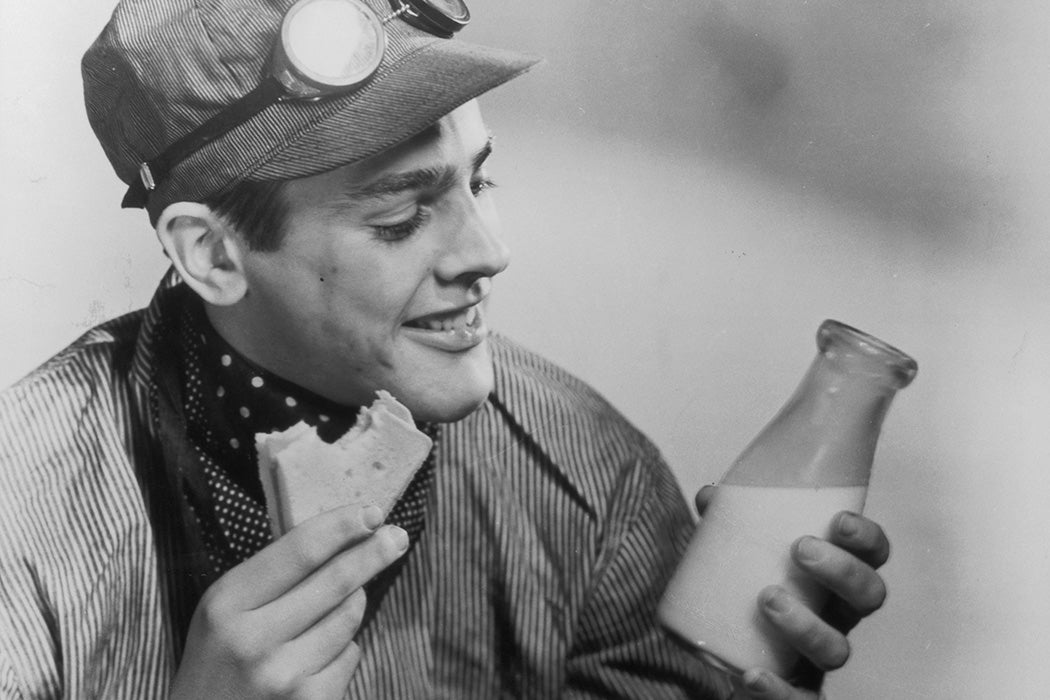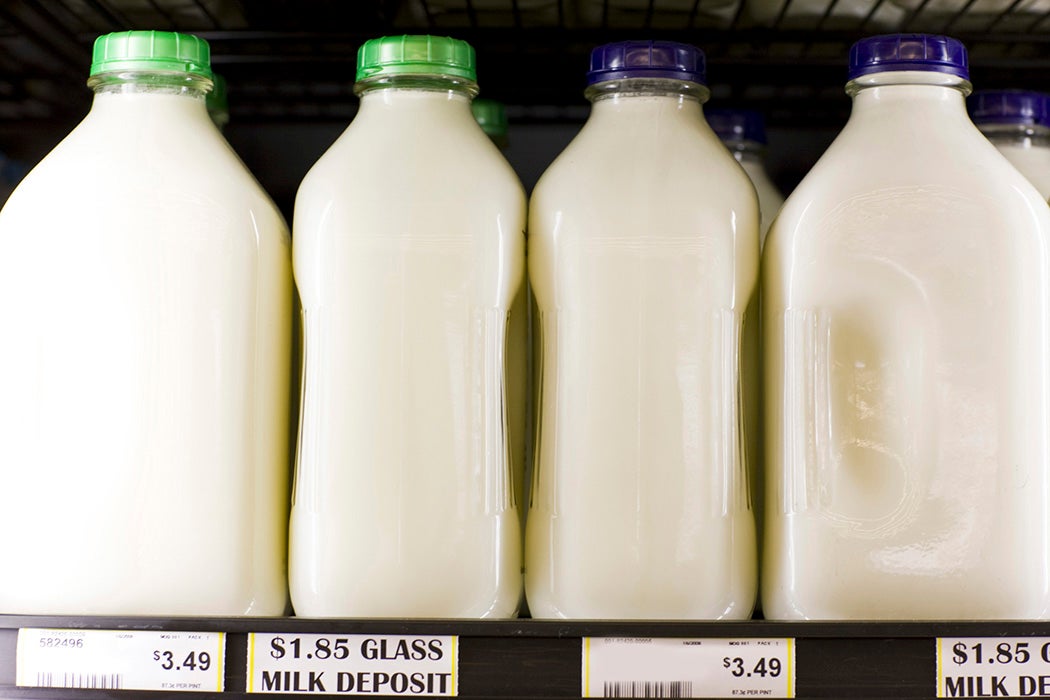Our compulsion to consume milk sets it apart from other foods. This compulsion comes—or at least came—from our belief that milk not just “does a body good,” but is also “nature’s perfect food.” Although environmental and health concerns are beginning to undermine our blind faith in milk, these beliefs maintained an ironclad hold over generations of American consumers. But how did milk take and keep that hold? The short answer is the image created for milk.
Milk’s image was not, and is not, a static product identity crafted by industry marketing specialists. It was and remains a shared perception of milk and its properties, continually shaped by a broad range of actors—often with different motivations—since the early 1840s. These actors have included dairy operators, associations, and promotional agencies along with politicians, regulators, journalists, and reformers. Each of their contributions added layers to milk’s image, making it both a fixture of American culture while also relevant to the given time.
“Unquestionable [pure] wholesomeness” has always been a fundamental quality ascribed to milk but was never enough to compel the level of consumption Americans eventually reached. The image required additional attributes. The first was “specialness,” explained by Andrea Wiley as milk’s portrayal as having unique but not necessarily genuine “properties able to alleviate the health concerns seen as most salient at the time.” The second was the implicit connection the image made between milk consumption and the “right” identity, which encompassed vitality, success, and whiteness. These attributes elevated milk’s place in the American diet from a minor one before the 1840s to a dominant one in the mid-twentieth century, with the average adult consuming 45 gallons per year—more than an oil barrel’s worth—by 1945.
Because milk’s image did not always match what consumers found in their cups, milk processing and milk itself underwent countless transformations. Both its image and these transformations made milk into “a historically unprecedented product of industrialization, urbanization, … and economics,” habitually consumed regardless of safety, affordability, or lactose tolerance. But the image’s success and milk’s ability to keep-up with that success have reached a critical juncture leaving the future of milk consumption in question.
Pure Wholesomeness
Milk’s contemporary image-making began in the rapid urbanization of mid-nineteenth century New York City, where its growing population was crowded into tenements plagued by malnourishment and disease. Milk’s early promise of pure wholesomeness answered their cravings.
Robert Hartley, among the first to call milk nature’s “perfect food,” introduced the idea of milk’s pure wholesomeness and part of moral lifestyle in keeping with his Second Great Awakening and temperance advocacy. He portrayed milk—something few Americans then drank—as both a virtuous replacement for alcohol and a solution to the malnourishment of impoverished urban children. This promotion of milk consumption eventually led Hartley to pure milk advocacy when he realized the appalling condition of the city’s milk supply.
Hartley connected his temperance and milk crusades in An Essay on Milk from 1842, arguing that milk produced in cities was impure not just because of its adulteration by contaminants like formaldehyde, but also because of its sourcing from urban swill sheds. These sheds were urban dairies attached to distilleries, where two thousand or more unhealthy cows were housed in unsanitary conditions and fed grain slop from alcohol fermentation. For Hartley, closing the sheds would kill the two birds of impure milk and alcohol with one stone.
Though his efforts met with failure, Hartley did succeed in creating a new image for milk. Early investigative journalists and social progressives adopted the idea that pure, wholesome milk was still essential despite rising milk-related mortality rates among city-dwelling children throughout the mid-1800s. These journalists and progressives were often NYC-based, addressing what Catherine McNeur described as the city’s unbounded growth and limited, corrupt government unable to keep-up with the few services it offered. The milk crisis became emblematic of the city’s problems and a focal point for advocacy.
Members of the New York Academy of Medicine and investigative journalists collected irrefutable evidence on swill milk, ranging from the physical status of swill cows and specific locations of swill sheds to swill milk’s “deleterious” effect on children. The Academy established a swill milk investigative committee under Dr. Augustus Gardner, though it failed to act on the committee’s damning findings.
Investigative journalists took the issue to the public. Mullaly published The Milk Trade in New York and Vicinity in 1853, promoting the novel idea of food-related sanitation measures for swill milk. Frank Leslie’s illustrated exposé Our Exposure of the Swill Milk Trade followed in 1858, fueling public reaction by coupling shocking revelations with graphic images vividly portraying urban milk’s deplorable state. Their coverage did not advise against drinking milk but instead defined milk as essential for children’s survival of diseases rampant in America’s cities. Milk therefore required saving from exploitive urban producers and adulterators who might enjoy political connections, visually portrayed in Currier and Ives’ “Swill Milk for Hungry Suckers” satirical illustration.
By the late 1850s, newspapers regularly decried government inaction in the face of the approximately eight thousand milk-related deaths a year, according to the New York Times’ 1858 coverage. Journalists publicly demanded broad food safety reforms, but government at all levels was slow to respond; federal authorities only got around to establishing the Food and Drug Administration (FDA) and the early twentieth century.
Given government inaction, the next best option reformers identified was importing milk from rural dairies. This option suited wealthy New Yorkers who wanted to push food production out of the city in their opposition to urban farming. It also suited consumers who associated milk purity with bucolic pastures and traditional lifestyles. The practice of rural sourcing, however, did not live up to expectations. Rural dairies had limited production capacity and were plagued by hygiene problems. Packaging and transport practices did not yet minimize handling-related contamination or spoilage. And consumers were unable to distinguish genuine rural milk from its countless urban imposters.
Because even rural sourcing did not deliver a sufficiently pure product to meet expectations set by the milk’s popular image, milk itself required transformation beginning with handling and distribution in the form of closed containers and refrigerated railroad cars. These innovations still did not deliver pure milk but did reshape the American milk market into one increasingly filled with professional dairies pumping out milk year-round.
Bacteriology advancements drove further milk transformations, which in turn turned milk’s image to hygienic production standards than bucolic country pastures. Small rural dairies, now considered the source of impure milk, were the new villains creating impure milk. The heroes of pure milk were better-resourced milk industrialists resulting from dairy consolidation, along with medical professionals including those in the new field of pediatrics. Together, they promoted and implemented hygienic production and distribution standards.
Newark-based pediatrician Henry Coit and the New Jersey Medical Society promoted this hygienic ideal by creating a voluntary certification process for dairies implemented by a medical commission that applied uniform nutritional, spoilage, and bacterial count standards. Approximately eighty commissions soon followed the original as certified milk became the new gold standard for purity, though milk remained raw and therefore vulnerable to pathogens. Uncertified milk remained on the market with small dairies lacking the resources to meet the new standards and consumers needing cheap options.
Milk’s Pasteurized Image
Industrial milk producers, along with a growing cadre of health professionals and reformers, eventually turned to pasteurization to deliver pure milk at an affordable cost. Pasteurization pushed milk farther towards what Wiley called a quintessentially modern, unnatural product. In the case of pasteurization, this “unnatural” quality triggered national debate regarding the extent to which this transformation changed milk’s natural wholesomeness by overheating its essential nutrients. Early debate was led by philanthropist Nathan Straus, who believed pasteurization was the only way to achieve milk purity, and Coit, who believed certification instead of pasteurization was the only way to ensure milk’s wholesomeness. This debate delayed pasteurization’s widespread adoption decades after news of the European “purification” process reached US soil in the 1880s.
Milk’s Post-Pasteurization Image
Because pasteurization finally delivered on purity, milk interests needed something to compel mothers to serve even more milk to their families. These interests shifted the image’s emphasis from hygiene to health, with the claim that milk delivered unique growth and vitality that enabled children to achieve physical ideals and middle-class lifestyle dream. Leaders of the milk industry as well as government officials used advertising to feature glowing, healthy–and white–children alongside medical professionals and sports stars sharing messages extolling milk’ nutritional returns.
Developments in nutritional science, from vitamin and mineral discoveries of the 1920s to USDA nutritional recommendations originated in 1894, enabled the milk industry to push this health image further by creating messaging that insufficient childhood consumption caused harmful calcium deficiency. The USDA’s Recommended Dietary Allowances (RDAs), along with other government-backed dairy promotion programs, amplified these messages. On its own, though, milk could not deliver on vitamin-based promises; it required Vitamin D fortification, which became standard by the 1930s.
Milk consumption surged going into both world wars, peaking in the mid-1940s. Production always had trouble keeping pace with demand, first falling behind but then exceeding it by the 1970s. Complicating this production issue was milk’s status as a flow commodity, which means its output level cannot be changed on a dime (cows produce milk daily) and surplus cannot be easily stored given its short shelf life. As dairies based their production level on the highest likely consumption rate so as not to leave demand unmet, excess milk inevitably flooded the market. Producers lobbied the government to both buy the surplus and pay dairies to reduce production, but overproduction continued. This overproduction created a major problem when demand sank in the 1980s and 90s as new sodas, flavored teas, juices, and power drinks inundated the beverage market. Milk had become a drudgery from which consumers increasingly opted out.
Milk interests needed a revival of its image’s “specialness.” By this point, these interests had professionalized organizations created to protect them and promote their product. These organizations, which began with local cooperatives or processor boards like Chicago’s Milk Producers’ Association, had evolved into strong regional processor associations, such as the California Milk Processor Board, and special interest bodies, such as the Milk Processor Education Program (MilkPEP). The government had also given the USDA a new mandate to promote dairy sales through mechanisms like the National Dairy Promotion and Research Board (NDB).

These organizations undertook various promotional activities, the most famous of which was the California Milk Processor Board’s “Got Milk” campaign launched in 1993 and later handed over to MilkPEP. Masterminded by advertising agency Goodby, Silverstein, & Partners, the campaign employed the familiar health messaging-celebrity combination but with a twist: a quirky mustache on the likes of Taylor Swift and tennis starlets Serena and Venus Williams. The implicit message: milk consumption brings all forms of success.
Although the mustache gained national recognition and the phrase “Got Milk” became a brand onto itself, the campaign failed to reverse milk’s decades-long consumption slide: by the campaign’s end in 2014, Americans were drinking less than half a cup a day.
Milk’s Wholesome Weight Loss Image
Industry associations needed to something needed to refocus milk’s image on Americans’ pressing health concern. In the 2000s, that concern was weight loss, set-up by the Surgeon General’s 2001 Call to Action to Prevent and Decrease Overweight and Obesity and the USDA’s 2005 national trans-fat warning.
New and revised campaigns equated milk with strong growth and slim waists. MilkPEP’s “Got Milk” added the phrase “Body by Milk” in 2006, featuring mustachioed celebrity-athletes like footballer David Beckham. This “Got Milk” version targeted teenagers by asserting that milk delivered a strong yet lean body. The non-profit National Dairy Council also launched the “3-A-Day” campaign claiming that consuming three daily dairy servings strengthened bones while shedding pounds.
The “3-A-Day” campaign drew criticism from consumer and health advocates because it was too closely connected to the industry’s lobbying of the USDA to increase recommended daily dairy servings to three cups. The watchdog organization Physicians Committee for Responsible Medicine’s division of advertising practices challenged the veracity of the campaign’s claims to the US government, involving the USDA and the Federal Trade Commission.
Other effective criticisms of milk’s pure wholesomeness soon followed. First were those questioning whether milk was the ultimate source of calcium essential for strong bones given research delinking milk from bone strength. These were joined by criticisms of industry and government recommendations’ blind spot regarding lactose intolerance as well as the contradiction between milk’s naturalness claims with its extensive transformations (such as synthetic bovine growth hormone used to increase cows’ milk output) and environmental footprint.
The Fate of Milk Today
Milk’s image is now at a critical juncture as its consumption continues a multi-decade decline, dropping from its peak of 45 gallons per adult per year in 1945 to approximately 11 gallons in 2019. Although milk’s image has been successfully revived in the past, the industry associations currently leading this revival have chosen a reactive strategy instead of finding a new way to make it special to Americans’ pressing health concerns. This strategy includes MilkPEP’s parody PSAs, which go on offensive against social criticisms in “Milk Shaming” featuring Queen Latifah, and against milk alternatives in “Wood Milk,” featuring Aubrey Plaza.
Milk associations are also waging war against milk alternatives that are attempting to coopt the attributes of milk’s image. These alternatives use the word “milk” or variations like “mylk” in their names. They simulate its taste, texture, and color while adorning the upper lips of young celebrities with “Silk ‘staches.” And they assert health benefits and a smaller environmental footprint than the animal-based original.
Associations like the National Milk Producers Federation are filing trade complaints with the FDA regarding alternatives’ use of the word “milk” and lobbying for the word’s congressional protection with legislation like the Senate’s 2017 “Dairy Pride Act.” Individual and collective milk interests are also pursuing lawsuits like the class-action suit brought against Trader Joe’s soymilk concluded in 2015 alleging that specific alternatives’ use of “milk” misleads consumers.
This word war over milk makes sense at first glance, with alternatives from soymilk to precision fermented dairy draining approximately two gallons per household per year from animal-based milk sales. But this loss is not behind milk consumption’s hard decline. The issue is that Americans no longer believe beverages with milk’s taste, texture, and promise are sufficiently special to warrant downing by the gallon. Freed from the compulsion to drink milk, Americans choose more interesting options, consuming almost as much soda in 2013 as milk in 1945. So while this word war may pump some life back into the vitality of milk’s image, it’s unlikely to improve the advantage of anything resembling milk in the broader beverage war.








